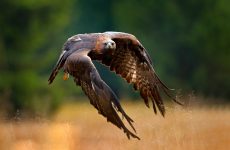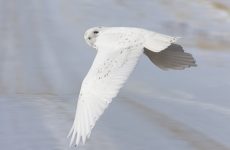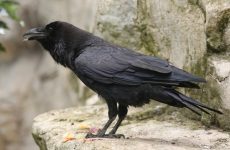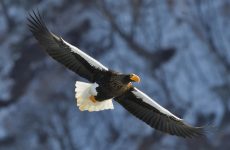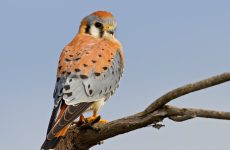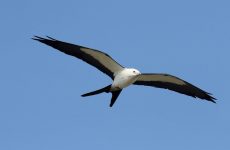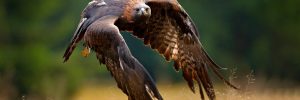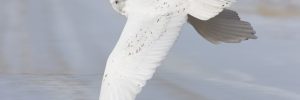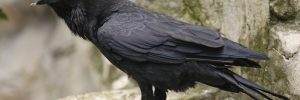Whether you are backyard birdwatching or out on a hike these are the most common birds that you will see in winter in New Brunswick.
How many have you spotted?
25 Common Winter Birds New Brunswick
1. Black-capped Chickadee
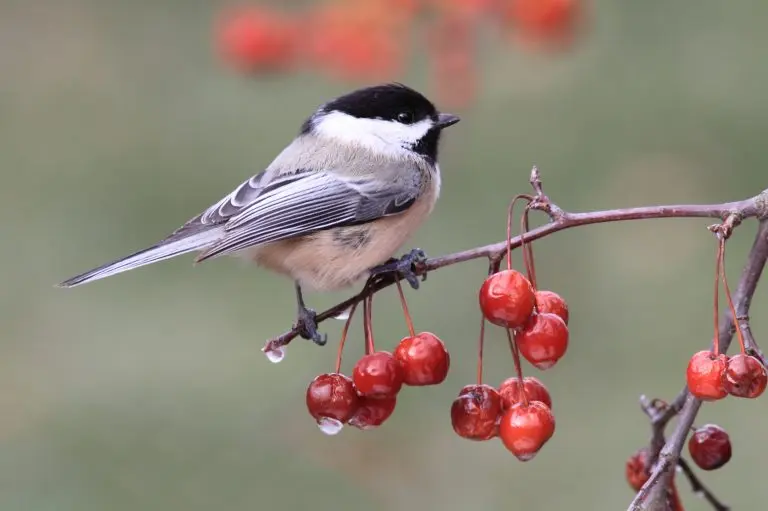
The Black-capped Chickadee is a cute bird with a big round head and tiny body. These birds will happily feed at backyard feeders and investigate everything, including you!
They have black caps and beaks, white cheeks, and are gray on the back, wings, and tail.
- Poecile atricapillus
- Length: 4.7-5.9 in (12-15 cm)
- Weight: 0.3-0.5 oz (9-14 g)
- Wingspan: 6.3-8.3 in (16-21 cm)
Black-capped Chickadees do not migrate and can be spotted in the northern half of the US and Canada.
You can find them in forests, open woods, and parks. Black-capped Chickadees eat seeds, berries and insects, spiders, and suet.
Black-capped Chickadee Call/Song:
Attract Black-capped Chickadees to your backyard with suet, sunflower seeds, and peanuts or peanut butter. They will even feed from your hand and are often one of the first birds to discover new feeders. They will also use nest boxes, especially if you fill them with wood shavings.
2. American Crow
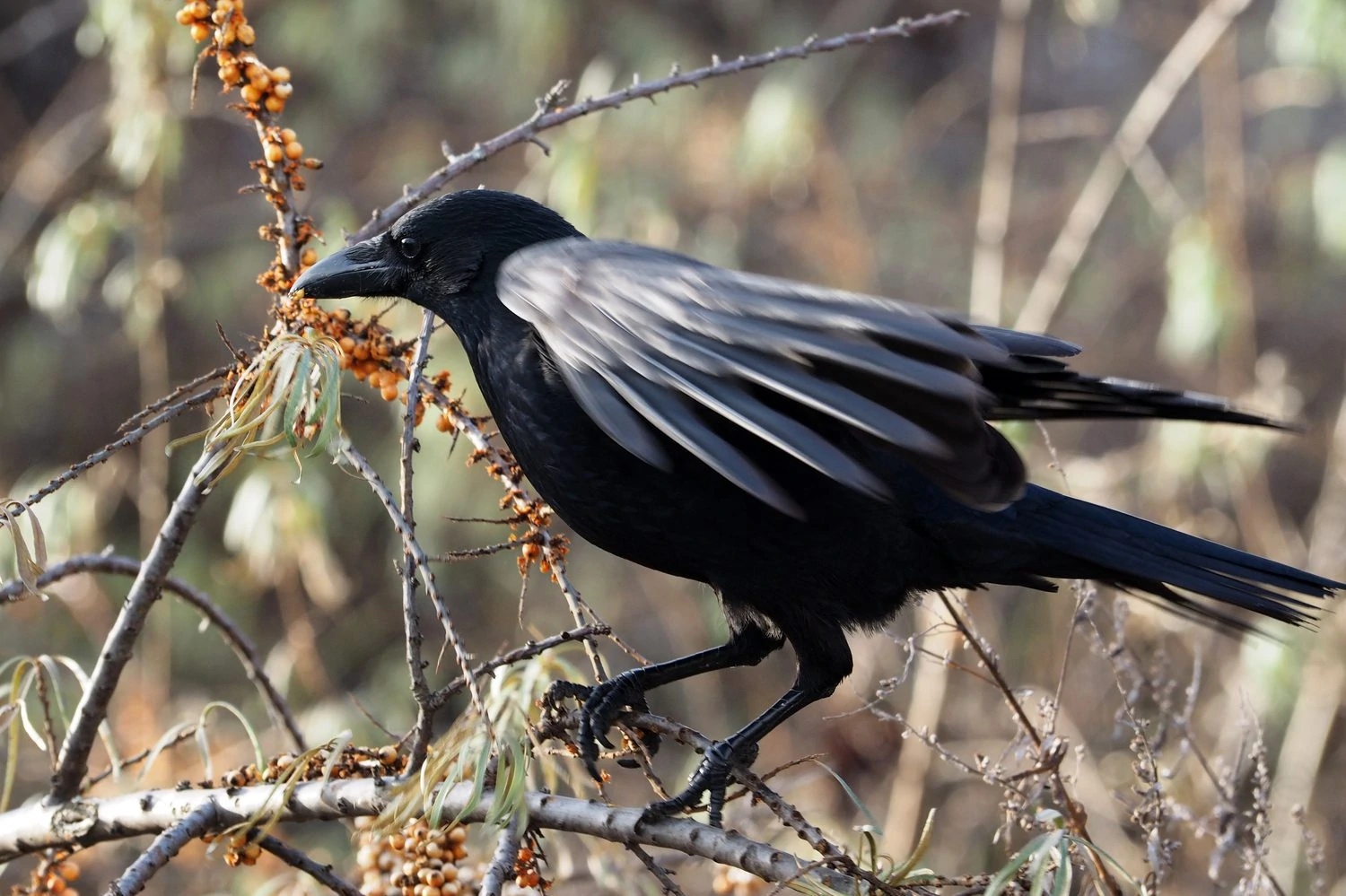
American crows are large all-black birds that make a hoarse, cawing sound.
- Corvus brachyrhynchos
- Length: 15.8-20.9 in (40-53 cm)
- Weight: 11.2-21.9 oz (316-620 g)
- Wingspan: 33.5-39.4 in (85-100 cm)
American Crows are residents all year in most of the lower 48 and the Pacific Coast in Canada and Alaska. Those that breed in Canada and the northern Midwest migrate south for winter.
They are common birds found in most habitats, including treetops, woods, fields, beaches, or towns.
They eat most things and usually feed on the ground, eating earthworms, insects, seeds, and fruit. They also eat fish, young turtles, mussels, and clams and will even eat eggs and nestlings of many species of birds.
In winter, American Crows gather in large numbers of up to two million crows to sleep in noisy communal roosts.
American Crow Call:
Attract American Crows to your backyard by scattering peanuts, but they can become a nuisance as they are attracted by garbage or pet food if left out.
3. Blue Jay
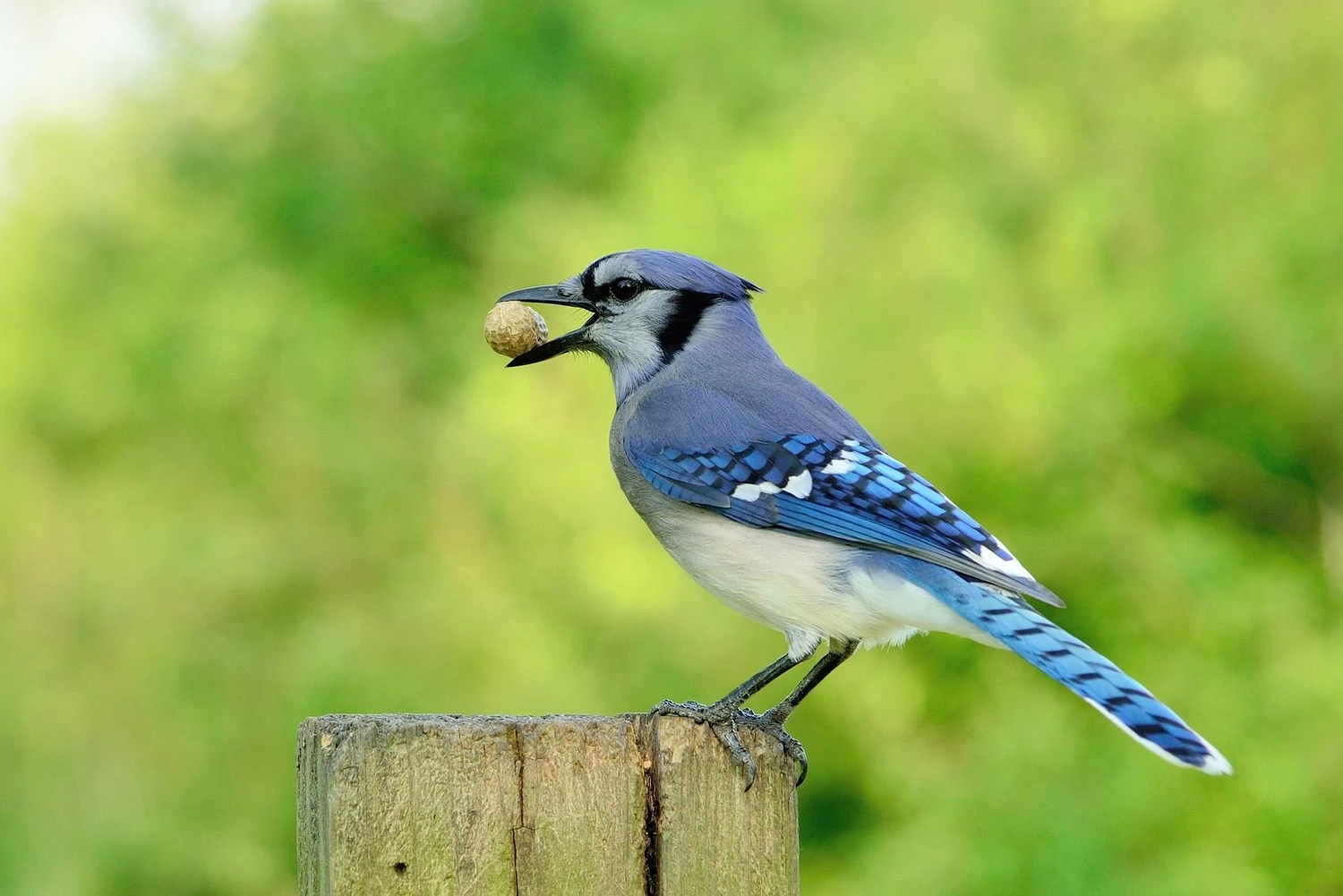
Blue Jays are common large songbirds with a blue upright crest, blue and black backs, and white undersides.
- Cyanocitta cristata
- Length: 9.8-11.8 in (25-30 cm)
- Weight: 2.5-3.5 oz (70-100 g)
- Wingspan: 13.4-16.9 in (34-43 cm)
Blue Jays live in eastern US states and Southern Canada all year. Some birds will migrate west for winter but not very frequently.
They are noisy birds that travel in family groups eating acorns when available. They can be found in forests, mainly near oak, as they eat acorns. They can also be found in backyards near feeders. As well as acorns, they eat insects, nuts and seeds, and grain. They may also take eggs from nests or take nestlings.
Blue Jay Call:
Blue Jays are large birds and prefer to fly in, grab a peanut or sunflower seed and take it away to feed. They prefer platform or tray feeders to make it easy to make a quick exit.
Attract Blue Jays to your backyard with peanuts, sunflower seeds, and suet. They prefer these on open tray feeders or hopper feeders on a post. They will also enjoy a birdbath.
4. Mourning Dove
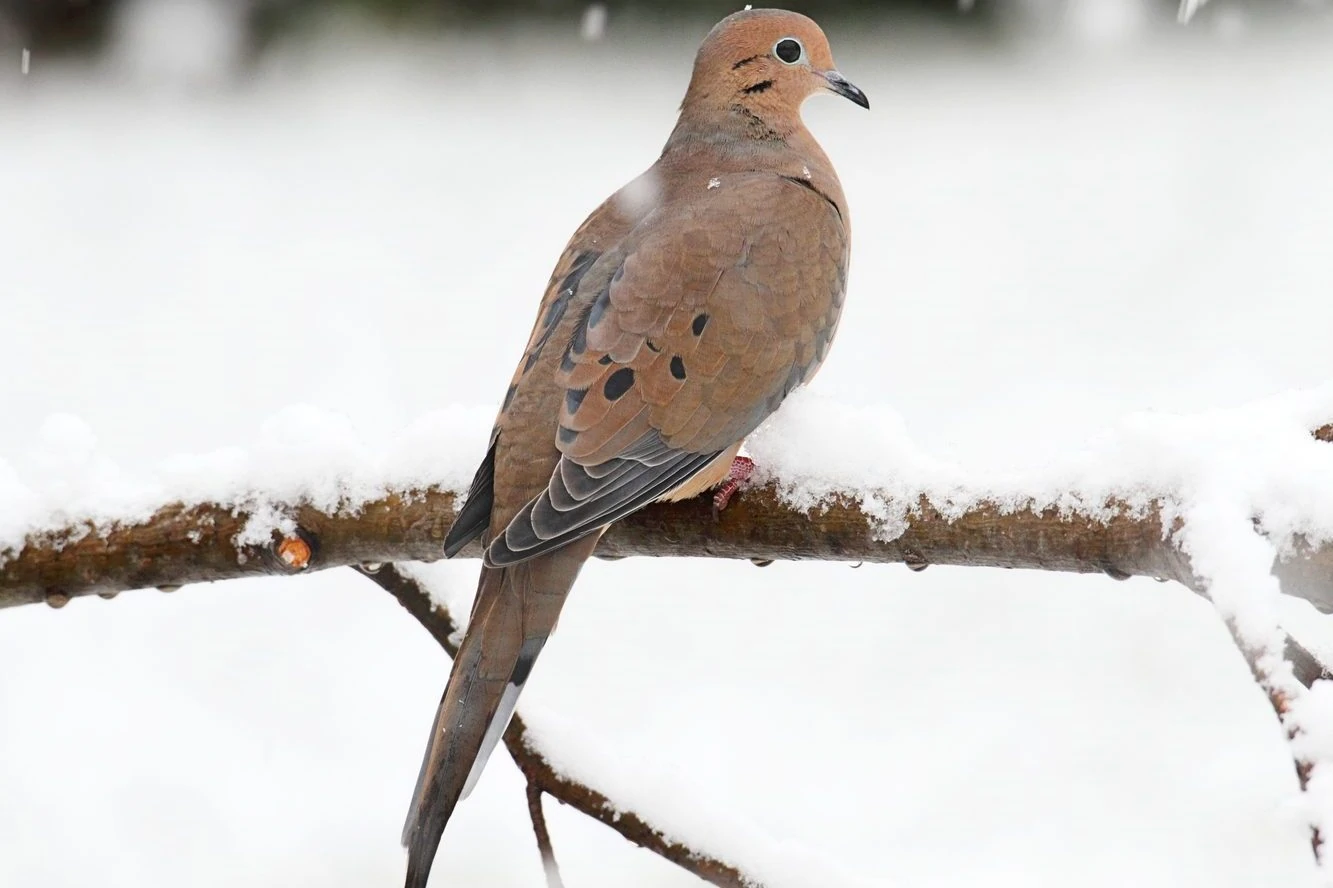
Mourning Doves are graceful small-headed birds with plump bodies and long tails. They are a soft brown color with black spots on the wings. Males are slightly heavier than females.
- Zenaida macroura
- Length: 9.1-13.4 in (23-34 cm)
- Weight: 3.0 -6.0 oz (96-170 g)
- Wingspan: 17.7 in (45 cm)
Mourning Doves are common over all of the lower 48 all year but may migrate after breeding from the north of the Midwest and southern Canada.
Mourning Doves can be seen perching on telephone wires and foraging for seeds on the ground in grasslands, fields, and backyards. They can also be found in open areas or woodland edges.
Mourning Dove call:
Attract Mourning Doves to your backyard by scattering millet on the ground or platform feeders. They will also eat black sunflower seeds, nyjer, cracked corn, and peanut hearts.
5. Herring Gull
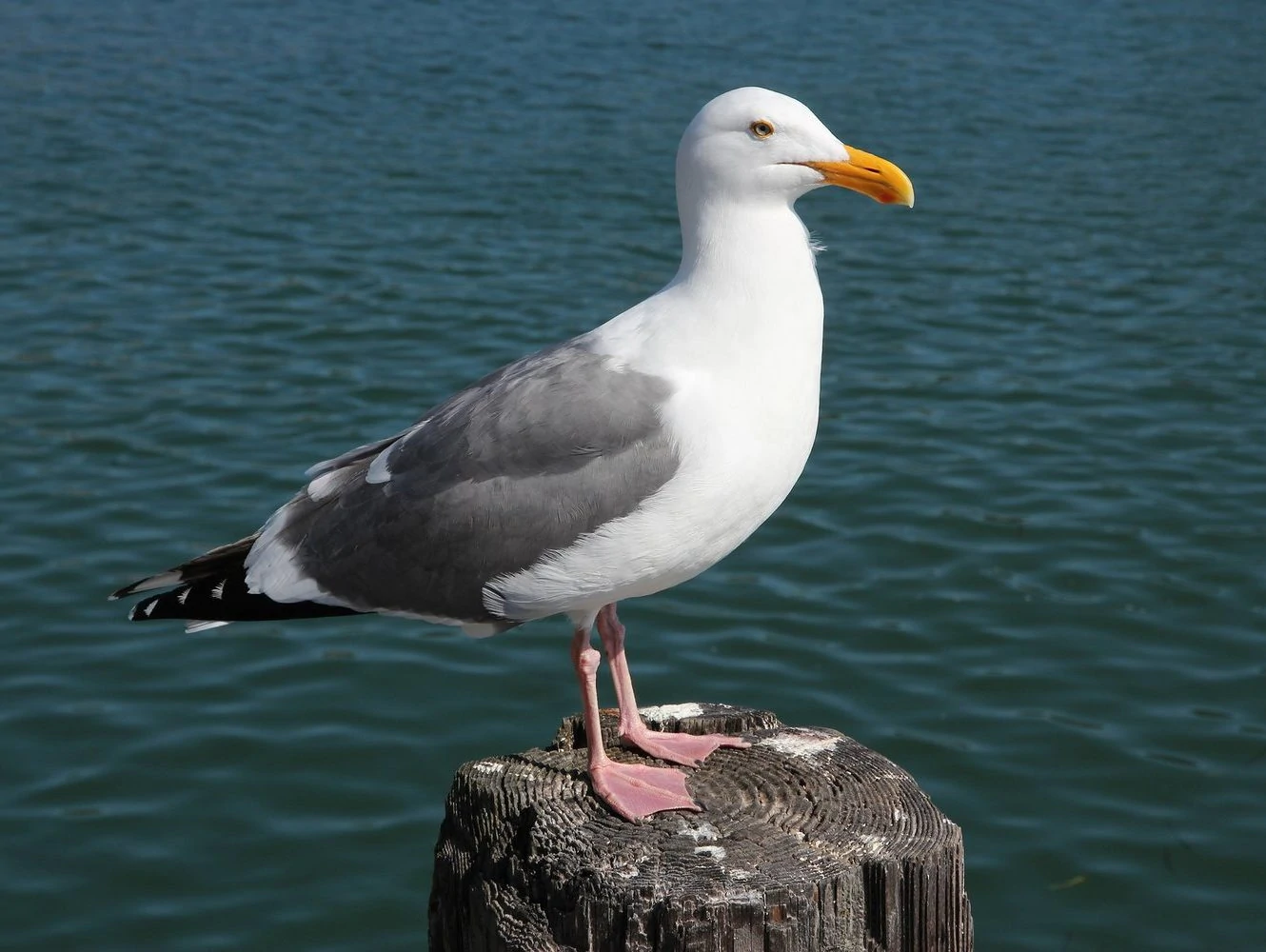
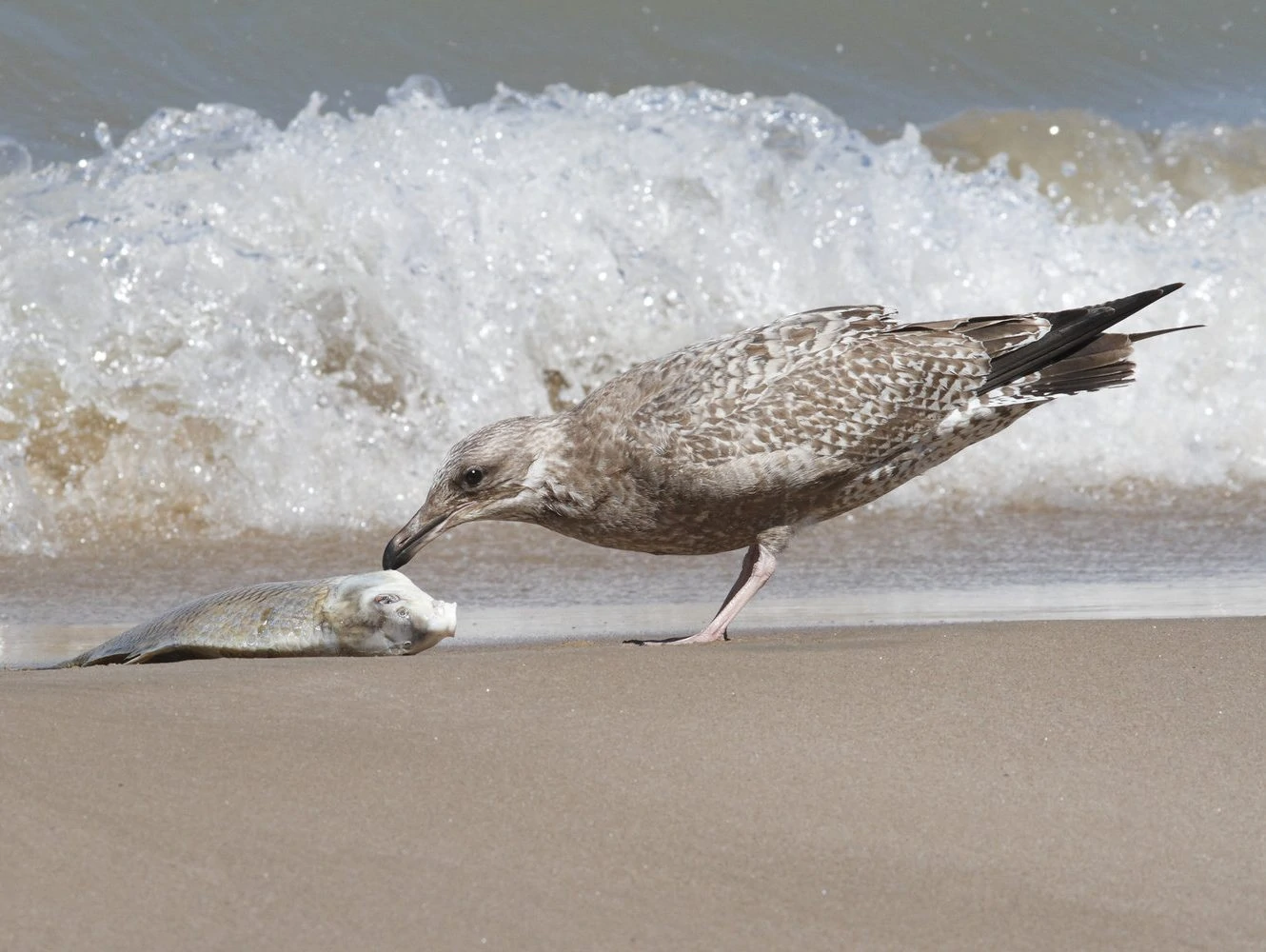
Herring Gulls are the usual ‘seagull’ you will spot, trying their luck to grab your lunch at the beach.
They are generally white with light gray backs and black-tipped wings. Their eyes are yellow with an orange outline. Their bills are also yellow but with a red spot at the tip of the lower mandible. Their legs are short and pink. Both males and females look similar.
Young birds take four years to reach their adult coloring. During their first winter, they are grayish-brown with extensive tan or brown streaking all over their bodies.
- Larus smithsonianus
- Length: 22 – 26 in (56 – 66 cm)
- Weight: 52.9 oz (1499 g)
- Wingspan: 54 – 58 in (137 – 147 cm)
Herring Gulls are found worldwide in the Northern Hemisphere. American Herring Gulls breed predominantly in Canada before migrating to the coasts of Canada and the United States and the Great Lakes and southeastern US states. Some remain all year along the coast and Great Lakes.
You can find Herring Gulls near open water but also at landfills, picnic grounds, and fish-processing plants when they’re foraging for food. Breeding areas include lakes near forests and coastal regions with isolated islands that are safe from ground predators.
Herring gulls are opportunistic feeders and on coastal shorelines, they will feed on mussels, crabs, crayfish, and sea urchins. On mudflats, they will eat worms and clams. In open water, they stay close to large fish and fishing boats that bring smaller fish and squid to the surface.
Herring gulls will even raid the nests of other seabirds to eat the chicks in their nests.
Herring Gull Call:
Fun Fact: Herring gulls are known to drop shellfish on hard surfaces, like rocks or roads, to break them open.
6. American Goldfinch
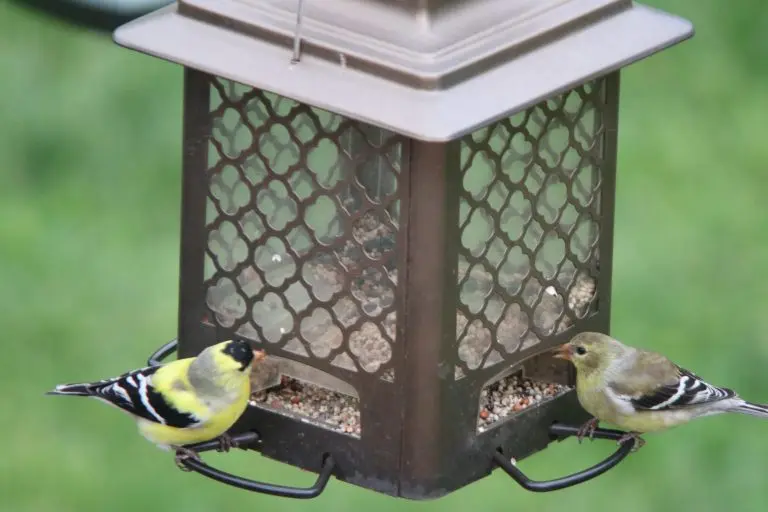
American Goldfinches are popular birds with the males’ bright yellow and black coloring in spring. The females are duller brown, as are males in winter.
- Spinus tristis
- Length: 4.3-5.1 in (11-13 cm)
- Weight: 0.4-0.7 oz (11-20 g)
- Wingspan: 7.5-8.7 in (19-22 cm)
American Goldfinches can be found in most of North America and are usually resident all year. However, those that breed in Canada and the Midwest migrate to southern US States for winter.
They can be found in weedy fields and overgrown areas foraging for sunflower, thistle, and aster plants. They are also common in suburbs, parks, and backyards.
American Goldfinch Song:
Attract American Goldfinches to your backyard by planting thistles and milkweed. They will visit most bird feeders and prefer sunflower seed and nyjer seed.
7. European Starling
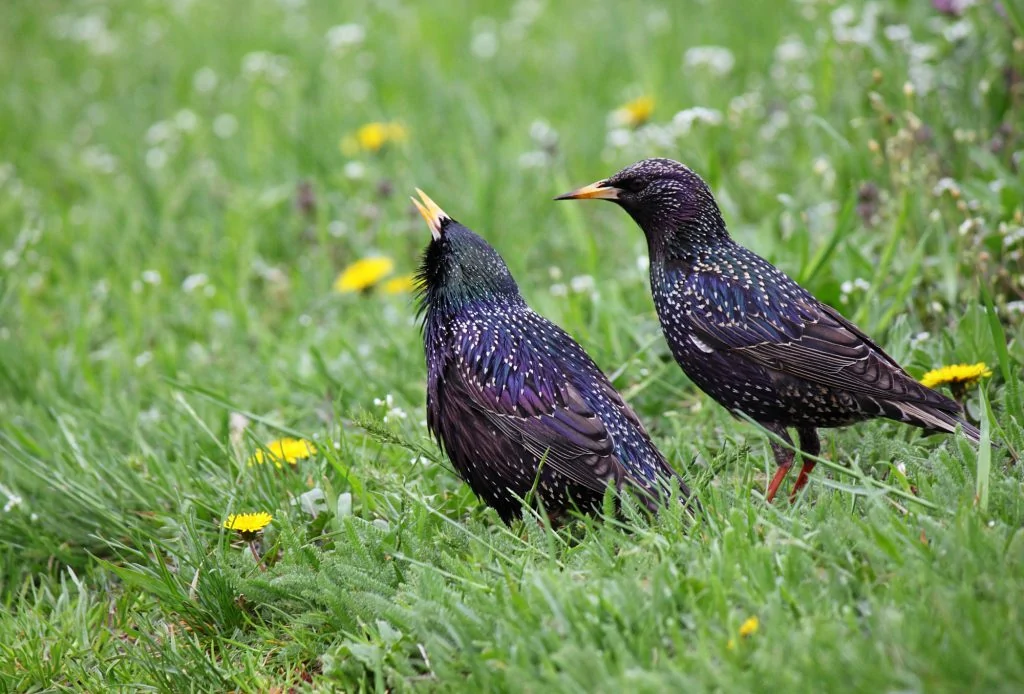
European Starlings are not native but are now one of the most numerous songbirds. They are stocky black birds with iridescent purple, green, and blue tones.
- Sturnus vulgaris
- Length: 7.9-9.1 in (20-23 cm)
- Weight: 2.1-3.4 oz (60-96 g)
- Wingspan: 12.2-15.8 in (31-40 cm)
European Starlings live in all of North America, except the north of Canada and Alaska.
They are considered a pest by some due to their aggressive behavior. These birds fly in large, noisy flocks and can be seen perched in groups on the top of trees or flying over fields.
European Starling Calls:
Starlings predominantly eat insects, including beetles, flies and caterpillars, earthworms, and spiders. However, they also eat fruit, including cherries, holly berries, mulberries, Virginia Creeper, sumac, blackberries, and grains and seeds.
Attract European Starlings to your backyard feeders with black oil sunflower seeds, suet, cracked corn, and peanuts.
8. Great Black-backed Gull
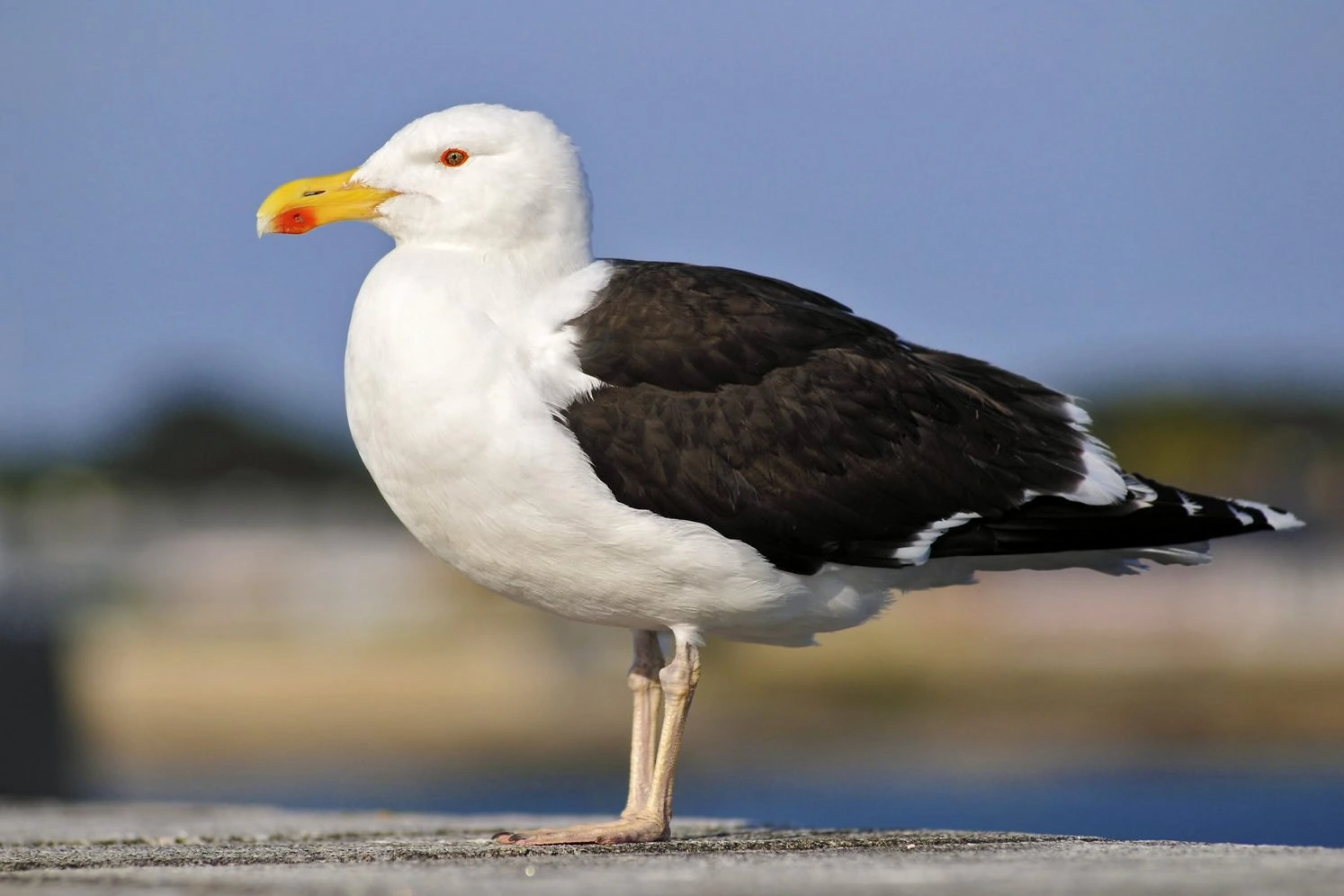
Great Black-backed Gulls are recognized as the world’s largest gulls and the only large gulls with black coloration on their wings and backs in the North Atlantic.
They have white heads and underparts, yellow eyes rimmed with red, large, yellow bills with a red spot, and pink legs.
Juveniles take four years to reach their mature form. During their first winter, they are streaked with gray-brown.
- Larus marinus
- Length: 25 – 31 in (64 – 79 cm)
- Weight: 64 oz (1814 g)
- Wingspan: 60 – 65 in (152 – 165 cm)
You can find Great Black-backed Gulls in many coastal environments like rocky and sandy beaches and estuaries. They also move further inland where there are large bodies of water like lakes, ponds, and rivers. They are also often seen at refuse dumps along the coast and even inland.
The primary food of Great Black-backed Gulls is fish which the snatch from near the surface of the water. However, Great Black-backed gulls are opportunistic feeders and will eat anything they can swallow. Among these, they eat squid, crabs, starfish, crustaceans, and mollusks.
They are very predatory and will target seabird eggs, nestlings, and fledglings. They will also hunt adult birds smaller than them like ducks, eiders, and cormorants. They will pursue them to exhaustion and continuously stab them with their bill. They will also steal food from other birds.
Great Black-backed Gull Calls
Fun Fact: Great Black-backed Gulls are known for having long lives. The oldest wild Great Black-backed Gull that has been recorded is 27.1 years.
9. Red-breasted Nuthatch
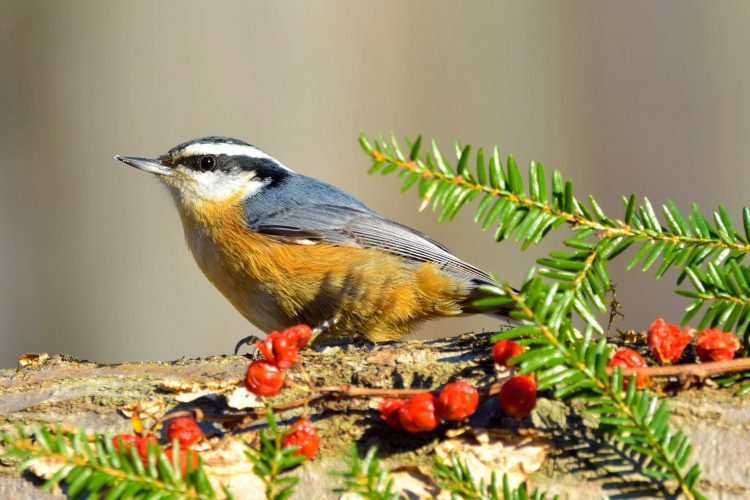
Red-breasted Nuthatches are blue-gray birds with black and white stripes on their heads and a rusty underside.
- Sitta canadensis
- Length: 4.3 in (11 cm)
- Weight: 0.3-0.5 oz (8-13 g)
- Wingspan: 7.1-7.9 in (18-20 cm)
Red-breasted Nuthatches remain all year in northeastern and western states, Alaska and Canada but may move south in winter if cone crops are poor.
You can find Red-breasted Nuthatches in coniferous woods foraging for cones, and they also visit backyard feeders.
Red-breasted Nuthatch Call:
Attract Red-breasted Nuthatches to your backyard with black oil sunflower seeds, suet feeders, peanuts, and mealworms.
10. Downy Woodpecker
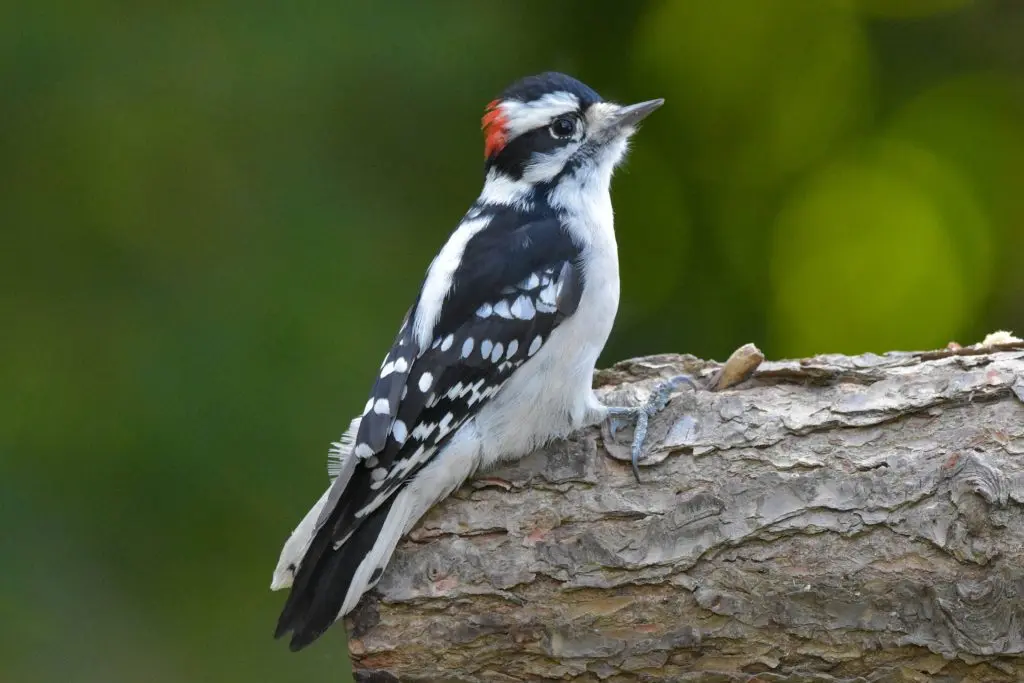
Downy Woodpeckers are small birds that are common at backyard feeders. They are often mixed in with other birds, such as chickadees and nuthatches.
They have black and white coloring with a red patch at the back of their heads. They look similar to the Hairy Woodpecker but smaller.
- Dryobates pubescens
- Length: 5.5-6.7 in (14-17 cm)
- Weight: 0.7-1.0 oz (21-28 g)
- Wingspan: 9.8-11.8 in (25-30 cm)
Downy Woodpeckers do not migrate and can be spotted in most states and provinces, except the north of Canada.
You can find Downy woodpeckers in woodlots, along streams, city parks, and backyards, and they eat mainly insects and beetle larvae but also berries, acorns, and grains.
Downy Woodpecker Call:
Attract Downy Woodpeckers to your backyard with their favorite treat of suet, but they will also eat black oil sunflower seeds, millet, and peanuts on platform feeders.
11. Common Raven
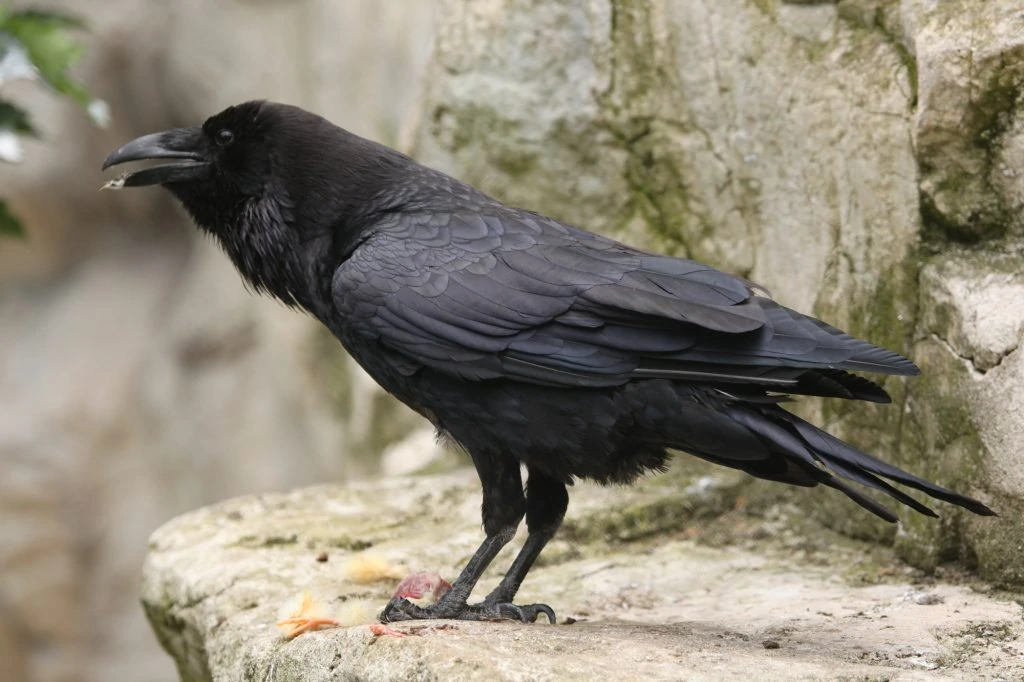
Common Ravens are thought to be one of the smartest and definitely one of the largest species in the songbird family. They have shaggy throat feathers, large black beaks, and wedge-shaped tails.
- Corvus corax
- Length: 22.1-27.2 in (56-69 cm)
- Weight: 24.3-57.3 oz (689-1625 g)
- Wingspan: 45.7-46.5 in (116-118 cm)
Common Ravens are resident in Canada, western US states, northeastern US states, Mexico, and northern Central America. They are not found in the Great Plains or eastern US states.
You can find Common Ravens in most places, and they especially follow humans. Forests, beaches, fields, grasslands are all places to find them and rural human areas. They are not common in towns and cities as American Crows take over.
Not known as picky eaters, Common Ravens will eat most things, including any small animals, eggs and nestlings, plus insects and fish. Human rubbish and pet food
Common Raven sounds: Mostly croaks and harsh calls
Fun Fact: Common Ravens in Canada weigh up to 60% more than those in California.
12. Hairy Woodpecker
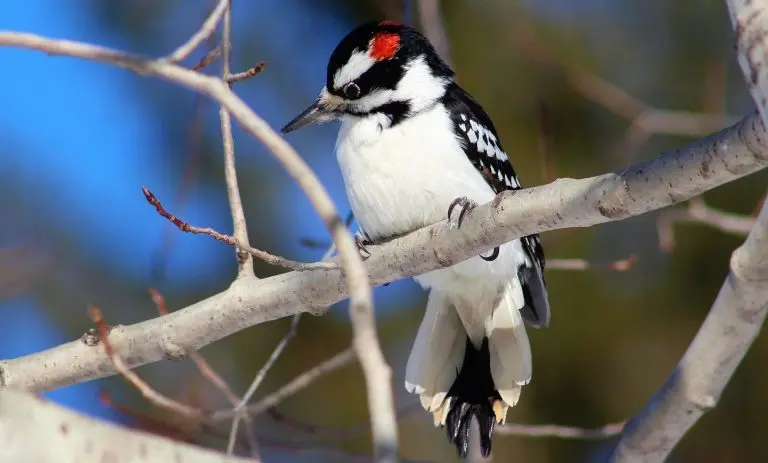
Hairy Woodpeckers are medium-sized woodpeckers with a black and white pattern and a large white patch on their backs. The males have a flash of red towards the back of their heads.
They are visually similar to Downy Woodpeckers but larger and with longer bills. As they are often found in the same areas, it is hard to tell them apart if they are not near each other.
- Dryobates villosus
- Length: 7.1-10.2 in (18-26 cm)
- Weight: 1.4-3.4 oz (40-95 g)
- Wingspan: 13.0-16.1 in (33-41 cm)
Hairy Woodpeckers do not migrate and live in all US states and Canada, except the far north of Canada.
You can find Hairy Woodpeckers in woodlands on trunks or main branches of large trees, but they are also found in a wide variety of habitats, including woodlots, parks, and cemeteries. Hairy Woodpeckers’ diet is mostly insects.
Hairy Woodpecker Call/drumming:
Attract Hairy Woodpeckers to your backyard with suet feeders.
13. Rock Pigeon
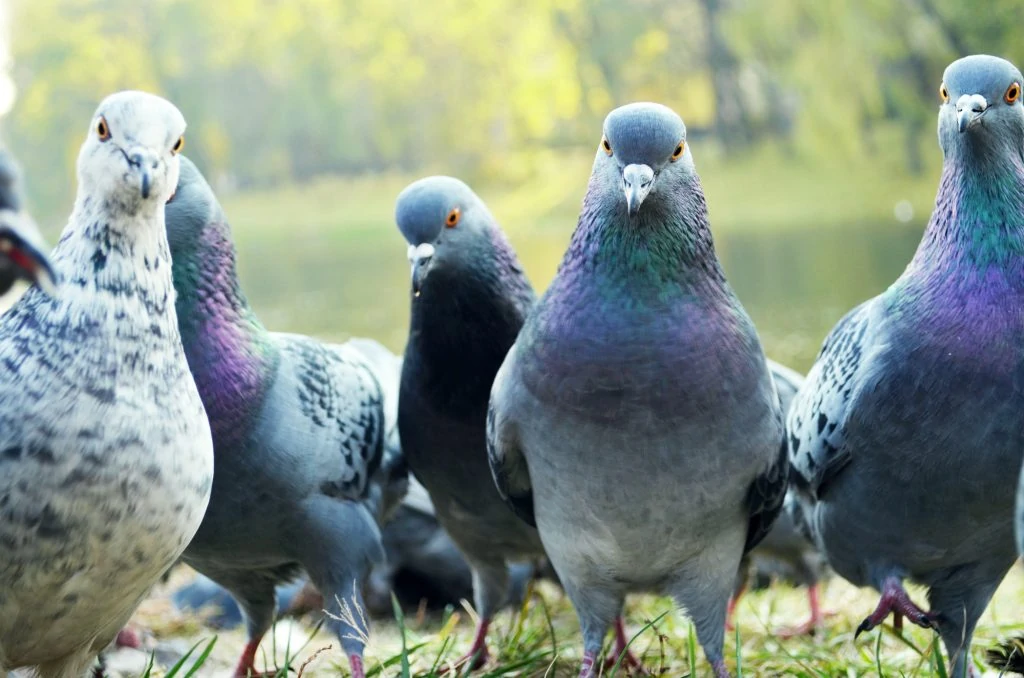
Rock Pigeons are well recognized around towns and parks and are usually blueish gray with two black bands on the wing and black on the tail tip. They have iridescent throat feathers and orange eyes.
However, they can also be white, spotted, or red.
- Columba livia
- Length: 11.8-14.2 in (30-36 cm)
- Weight: 9.3-13.4 oz (265-380 g)
- Wingspan: 19.7-26.4 in (50-67 cm)
Rock Pigeons do not migrate and can be found in all US states, southern Canada, and the Pacific Coast to Alaska.
You can find Rock Pigeons in cities, parks, and backyards, especially if there is birdseed on the ground. Some cities have ordinances against feeding pigeons as they are considered pests.
Rock Pigeon Call:
Fun Fact: Rock Pigeons have an amazing ability to find their way home using the earth’s magnetic field.
14. American Black Duck
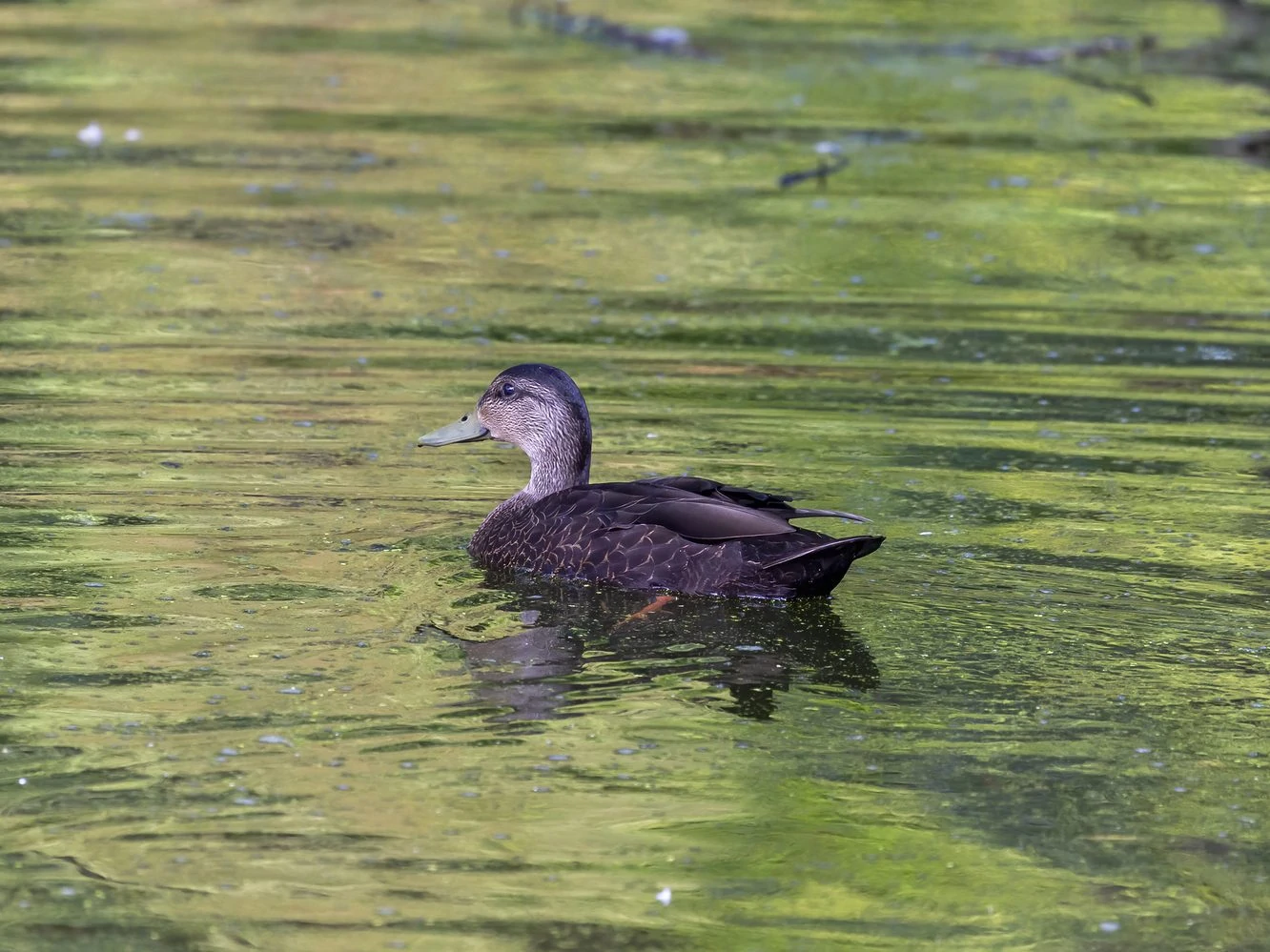
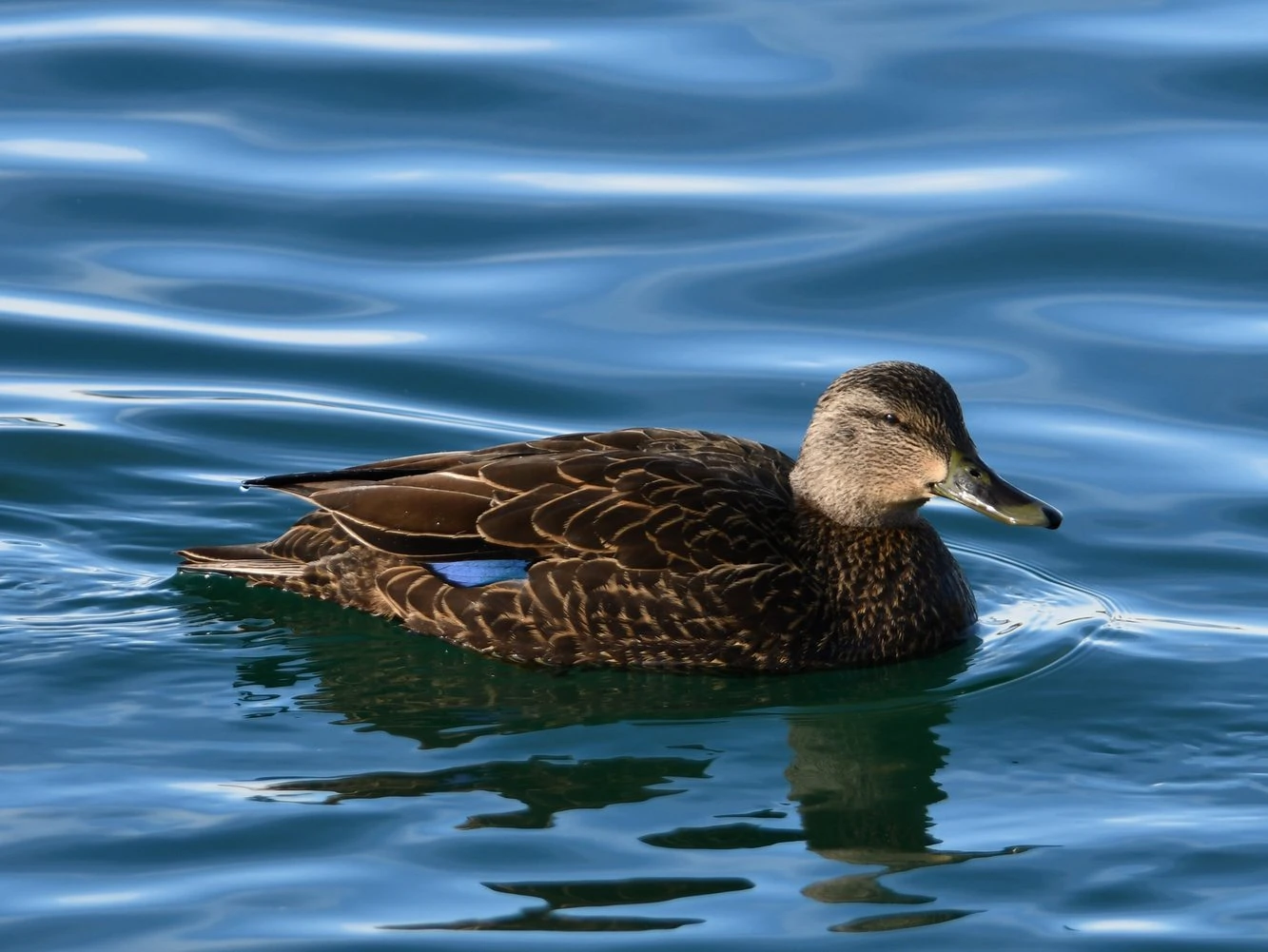
American Black Ducks are large, heavy ducks from the Anas family. They’re quite possibly the heaviest ducks in the species. Males and females have the same dark brown bodies and pale brown heads. Males have a yellow bill, and females have an olive one. The only bright colors on their bodies are the blue-purple patch on their wings and their red-orange legs.
- Anas rubripes
- Length: 19 – 23 in (48 – 58 cm)
- Weight: 49.6 oz (1406 g)
- Wingspan: 33 – 36 in (84 – 91 cm)
American Black Ducks are found in eastern regions. They breed in eastern Canada and spend the winter in eastern US states. Some remain all year in northeastern US states.
You can find American Black Ducks in many different habitats. Ordinarily, they inhabit salt marshes, lakes, ponds, and estuaries. They are also seen in forested swamps, beaver ponds, agricultural fields, and flooded woods. Also, they may reside in tidal marshes, and when they want to hide from hunters, they stay on conservation land.
American Black Ducks can look for food on both land and water. Aside from dabbling, they also graze on land. They eat aquatic vegetation, animals like snails, insects, mussels, small fish, and grasses and seeds from fields.
American Black Duck calls: Male American Black ducks have a more reedy call than the females’ loud quack.
Male American Black Duck
Female American Black Duck
Fun Fact: 11,000-year-old fossils of American Black Ducks have been discovered in Florida and Georgia.
15. Dark-eyed Junco
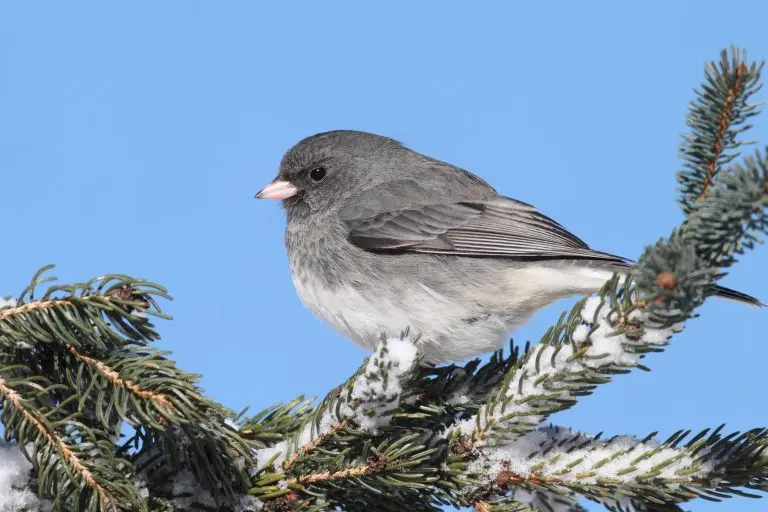
Dark-eyed Juncos are sparrows that are different colors depending on the state. They are generally slate-colored in the east and black, white, and brown in the west.
- Junco hyemalis
- Length: 5.5-6.3 in (14-16 cm)
- Weight: 0.6-1.1 oz (18-30 g)
- Wingspan: 7.1-9.8 in (18-25 cm)
Dark-eyed Juncos remain resident all year in northeastern and western US states and the Appalachian Mountains. Those that breed in Canada and Alaska migrate south in winter to the United States.
They can be found in open and partially wooded areas, often on the ground, and are common across the continent.
Dark-eyed Junco Song:
Attract Dark-eyed Juncos to backyard feeders with a variety of seeds such as black oil sunflower seeds, nyjer, cracked corn, millet, and peanuts. Platform feeders or scattered on the ground are best.
16. Bald Eagle
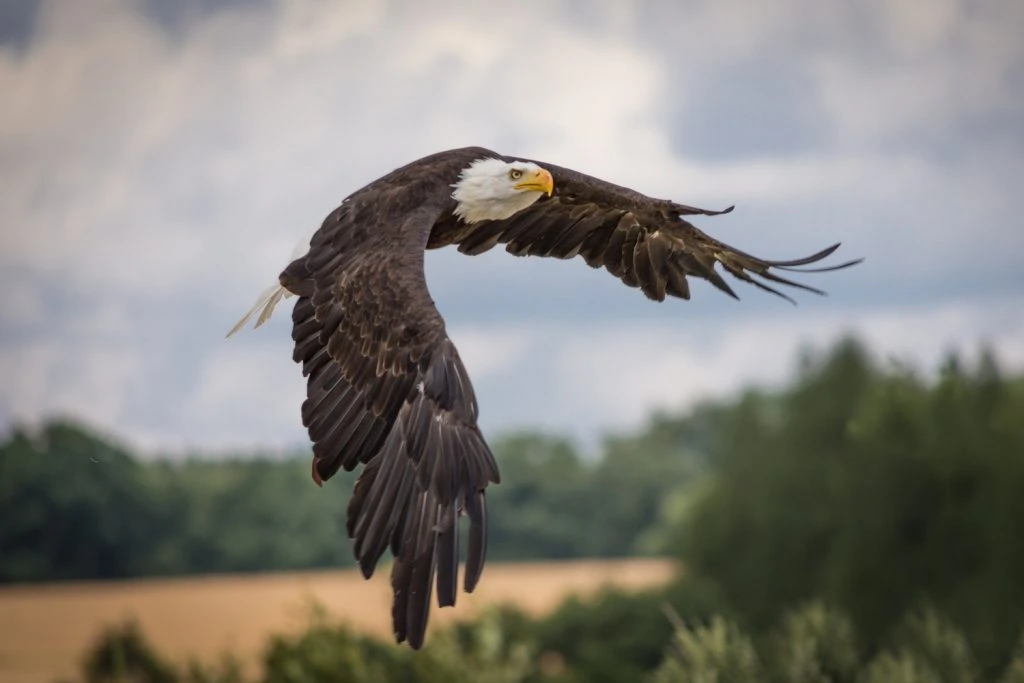
The Bald Eagle is a widely-recognized bird of prey. It has a white head, yellow eyes, and a large, hooked yellow bill. Its body is chocolate brown, and its legs are yellow, with huge talons.
Females look similar to males, except they’re about 25% larger. Juveniles have dark brown heads and bodies with variable white mottling or streaking until they reach their fifth year.
- Haliaeetus leucocephalus
- Length: 34 – 43 in (86 – 109 cm)
- Weight: 168 oz (4761 g)
- Wingspan: 72 – 96 in (183 – 244 cm)
Bald Eagles breed predominantly in Canada and then migrate to the United States for winter. However, some remain resident all year, especially in coastal regions.
You can find the Bald Eagle, during its breeding season, in wetland environments. Open and large bodies of water with plenty of fish are ideal spots.
When they’re nesting, roosting, or perching, Bald Eagles need tall, mature, and large trees for good visibility and have to have an open structure allowing the Bald Eagles to see the forest floor, and must be near water, especially when nesting.
In the winter, Bald Eagles flock to spots with a lot of perches around unfrozen water with plenty of fish. When there’s no available unfrozen water source, Bald Eagles will congregate in open habitats with medium-sized mammals like in prairies and meadows.
Bald Eagles are opportunistic feeders and will eat what is available in their environment. Their favorite food is fish, and they prefer large ones, like trout and salmon. They may hunt these fish themselves or steal them away from other birds. Sometimes, they also eat carrion (dead) fish.
They also eat medium to large-sized birds, like ducks, herons, owls, and geese. During winter, bald eagles turn to mammals for their prey when fishing for food is not as lucrative. They will initially target weak, dying, or young prey. They hunt rabbits, squirrels, raccoons, beavers, and deer fawns.
Bald Eagle Calls: The squeak of the Bald Eagle does not fit its size as they make a rather disappointing high-pitched whistle!
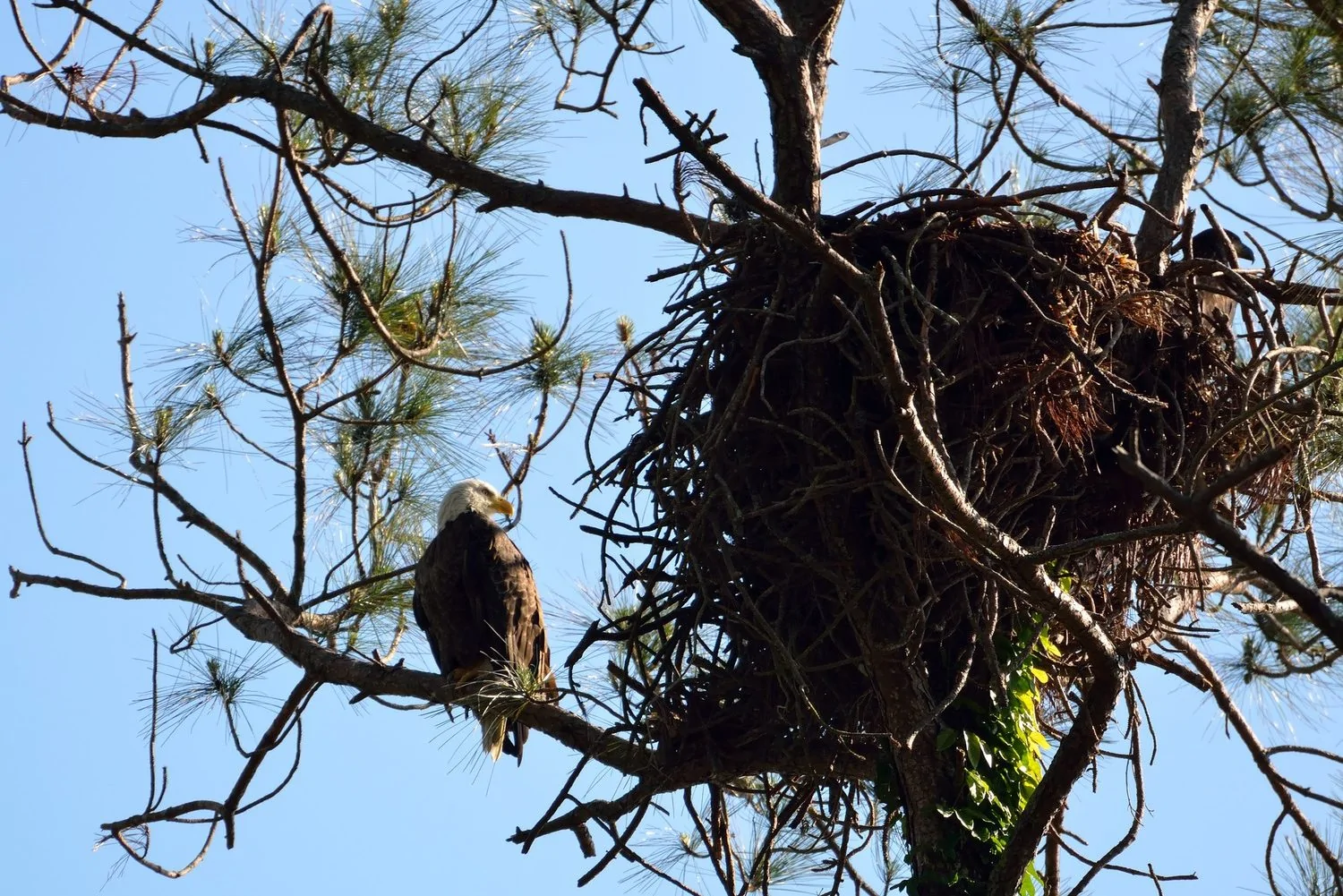
Females may lay one to three eggs per year in the wild. In captivity, they may lay up to seven eggs. The parents take turns in incubating the eggs for thirty-five days. Whoever is not sitting on the eggs gets to hunt for food to feed the other.
Fun Fact: The Bald Eagle has been the national symbol of America since 1782. It may be named “bald,” but it isn’t actually bald. The old version of “bald” actually meant “white,” referring to its white head and tail.
17. American Tree Sparrow
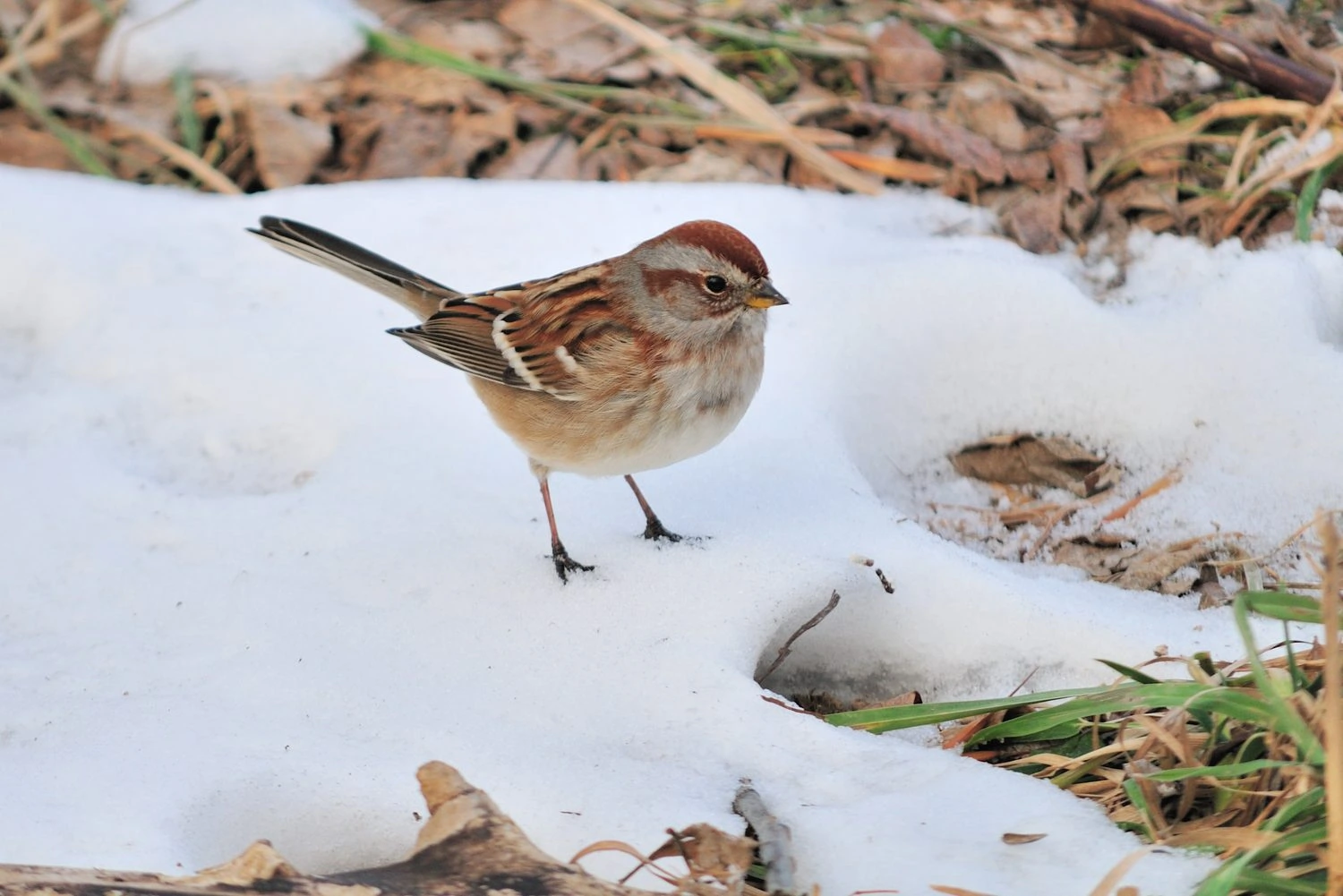
- Spizelloides arborea
- Length: 5.5 in (14 cm)
- Weight: 0.5-1.0 oz (13-28 g)
- Wingspan: 9.4 in (24 cm)
18. Mallard
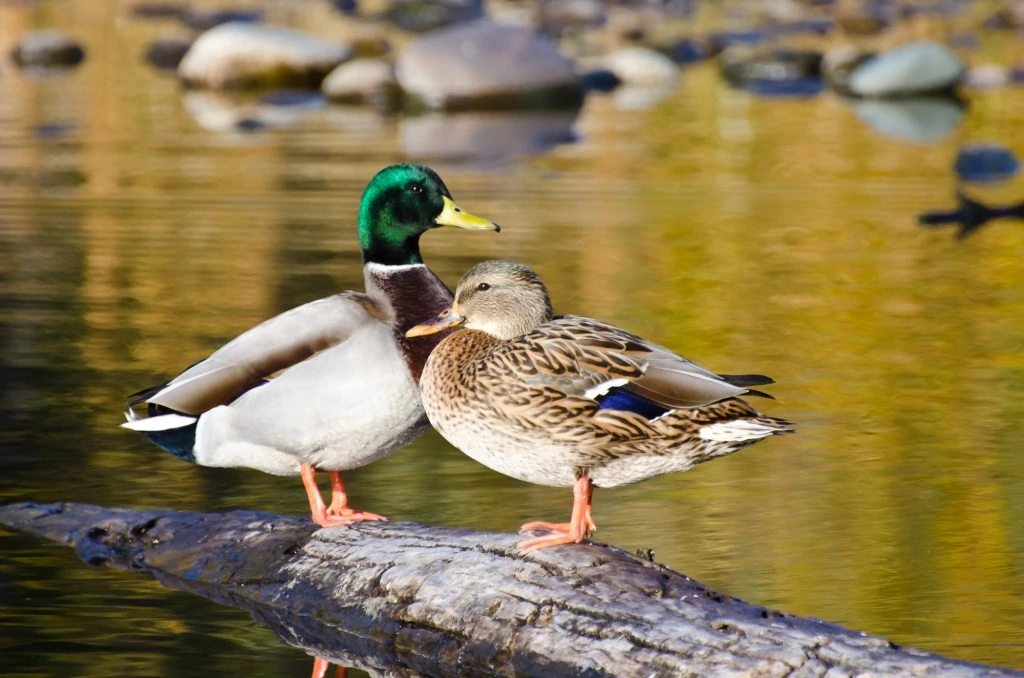
Mallards are large ducks, and the males have striking green heads. They also have bright yellow bills and gray bodies with brown breasts and black towards the tail. They have a curl of tail feathers and a blue patch on the wings bordered with white which is called a speculum.
Females and juveniles are mottled brown with orange bills but still have the blue speculum.
- Anas platyrhynchos
- Length: 19.7 – 25.6 in (50 – 65 cm)
- Weight: 35.3 – 45.9 oz (1000 – 1300 g)
- Wingspan: 32.3 – 37.4 in (82 – 95 cm)
Mallards remain all year in most of the lower 48 and the western coast of Canada and Alaska. Those that breed in Canada and Alaska head south to the southern United States and northern Mexico.
Mallards are one of the most commonly spotted and recognizable ducks that will happily be fed on ponds and rivers. They are dabbling ducks that feed on water plants and do not dive. They are very long-lived, and they have been recorded at 27 years old.
Mallard Calls:
Male Mallards don’t quack, only females do. Instead, the male makes a rasping sound.
Male Mallard Call
Female Mallard Call
Fun Fact: Most domesticated ducks are descended from Mallards, and they have been hunted and bred for food.
19. Red-breasted Merganser
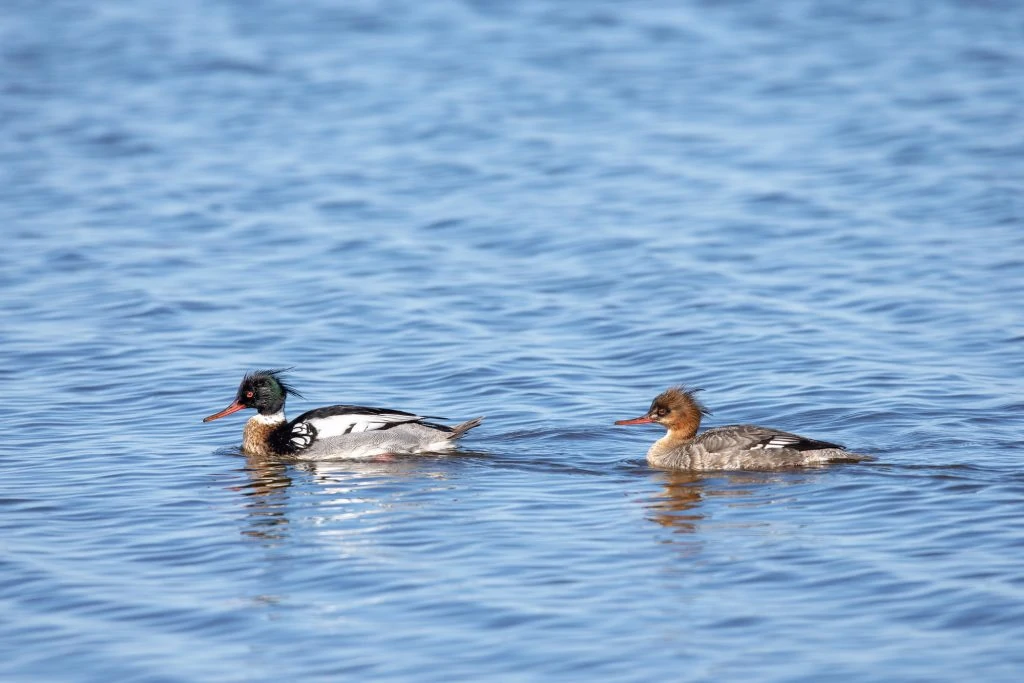
Breeding Male Red-breasted Mergansers are certainly noticeable ducks. Their black, glossy green, ragged, and spiky crests, dark red eyes, and long, serrated orange bills certainly make them stand out among other ducks. They also have a white neck collar, mottled reddish-brown breast, black and white back, and gray flanks.
Females and non-breeding males have reddish-brown spiky crests, red eyes, long, red bills, white throats, and gray bodies.
- Mergus serrator
- Length: 16 – 26 in (41 – 66 cm)
- Weight: 47.61 oz (1349 g)
- Wingspan: 31 – 35 in (79 – 89 cm)
Red-breasted Mergansers breed in Canada, except in the southwest, before migrating to the coasts of the US and Canada. They can be spotted during migration in southwestern Canada and all US states.
You can find Red-breasted Mergansers in tundra ponds, freshwater lakes and rivers, and brackish and saltwater wetlands, usually near the coast during the breeding season. In winter, they may also be found in the ocean.
Red-breasted mergansers normally dive when foraging for food and will pursue their prey underwater until they catch them. They will occasionally cooperate with other groups and herd schools of fish into shallow waters to make them easier to catch. Aside from fish, they also eat crustaceans, insects, and amphibians.
Red-breasted Merganser call: They are quiet birds, but they make calls during courtship or when alarmed.
Male Red-breasted Merganser
Female Red-breasted Merganser
Fun Fact: Red-breasted Mergansers don’t acquire their breeding feathers until they are two years old.
20. Common Eider
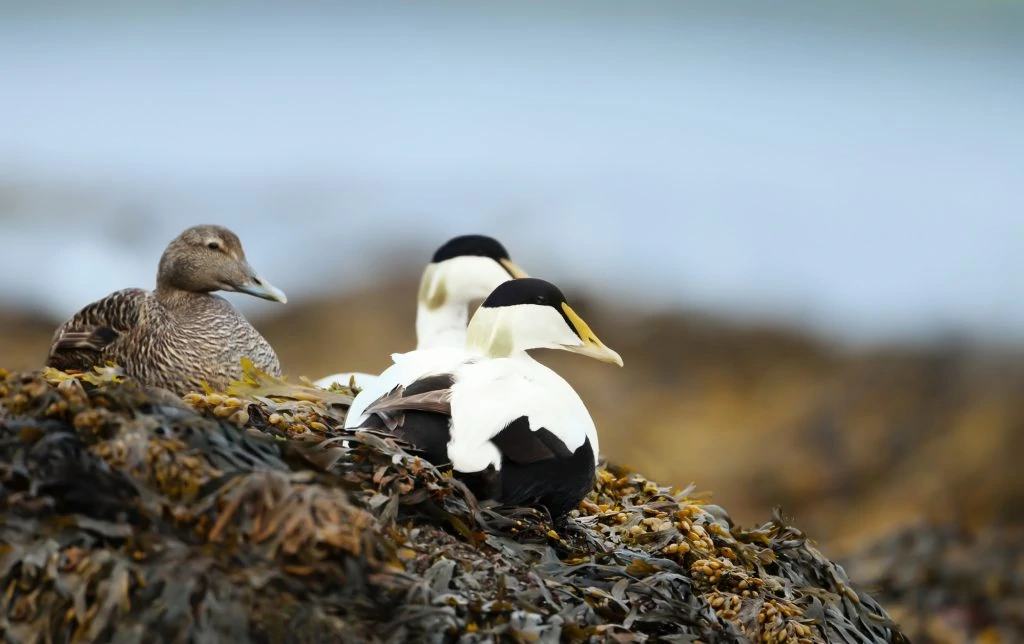
Common Eiders are large sea ducks with sloping foreheads. Breeding males generally have white cheeks and backs, black caps, sides, and bellies, and pistachio-colored napes (back of the neck).
Females are reddish-brown all-over with black barring on their breasts, backs, and wings. Juveniles and non-breeding males are chocolate brown with varying degrees of white coloring on their breasts and backs.
- Somateria mollisima
- Length: 23 – 27 in (58 – 69 cm)
- Weight: 78.4 oz (2222 g)
- Wingspan: 35 – 42 in (89 – 107 cm)
Common Eiders have six subspecies, four of which breed in North America and have slight differences between them.
Common Eiders breed in Canada and Alaska and parts of northern Europe and Asia. Some remain in those areas in winter all year, but others migrate south.
You can find Common Eiders in marine or saltwater habitats that are near rocky coastlines. During the breeding season, you can find them in large colonies on coastal islands, islets, and shorelines with vegetation, shrubs, and stunted trees.
In winter, they settle in locations with rocky seafloors to easily forage for mollusks.
Common Eiders mainly eat mollusks, crustaceans, marine worms, and fish eggs. They forage at low tides and pry these mussels from rocks underwater with their strong, chisel-like bills.
They are able to swallow the mussels whole despite their shells. When eating crabs, they only eat the bodies and remove all of their legs and claws prior to eating.
Common Eider calls:
Male Common Eider
Female Common Eider
Fun Fact: The Common Eider is also called St. Cuthbert’s Duck or Cuddy’s Duck because they were one of the first birds ever to gain protection laws as established by Saint Cuthbert in the year 676.
21. Iceland Gull
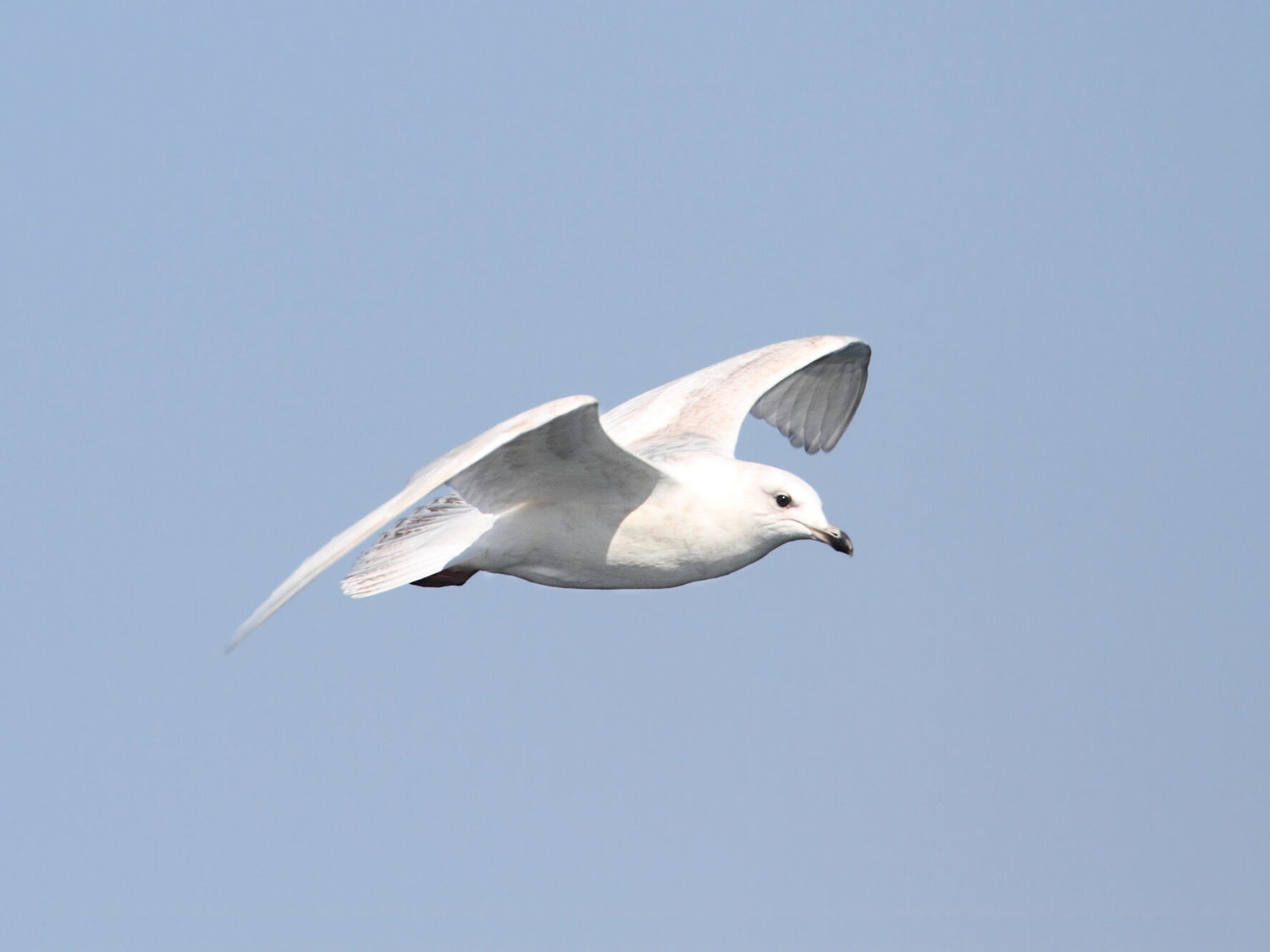
Iceland Gulls are medium-sized gulls from the arctic with pale gray backs and wings and are and white elsewhere. Adults have slim yellow bills.
In winter they have pale brown mottling on their chests and head.
Juveniles are mottled light brown and white and then start to develop the gray color slowly and their bills change from black to yellow.
- Larus glaucoides
- Length: 19.7-23.6 in (50-60 cm)
- Weight: 28.9-38.8 oz (820-1100 g)
- Wingspan: 45.3-53.9 in (115-137 cm)
Iceland Gulls breed in the arctic and may move to the US and Canadian northern coasts in winter. Some spend winter in Iceland and the UK.
You can find Iceland Gulls breeding on coastal cliffs in the arctic in summer. In winter they are found close to shore and beaches and may move south a little.
Iceland Gulls mainly eat fish but they will also eat mussels and snails and eggs and young of other birds.
Iceland Gull calls:
Nests of Iceland Gulls are a bowl made from grass, moss and vegetation material placed on a cliff ledge. Up to 100 birds will form a colony.
The female lays up to four eggs which take about 25 days to hatch. They look after their young for a further 6 or 7 weeks.
22. Common Redpoll
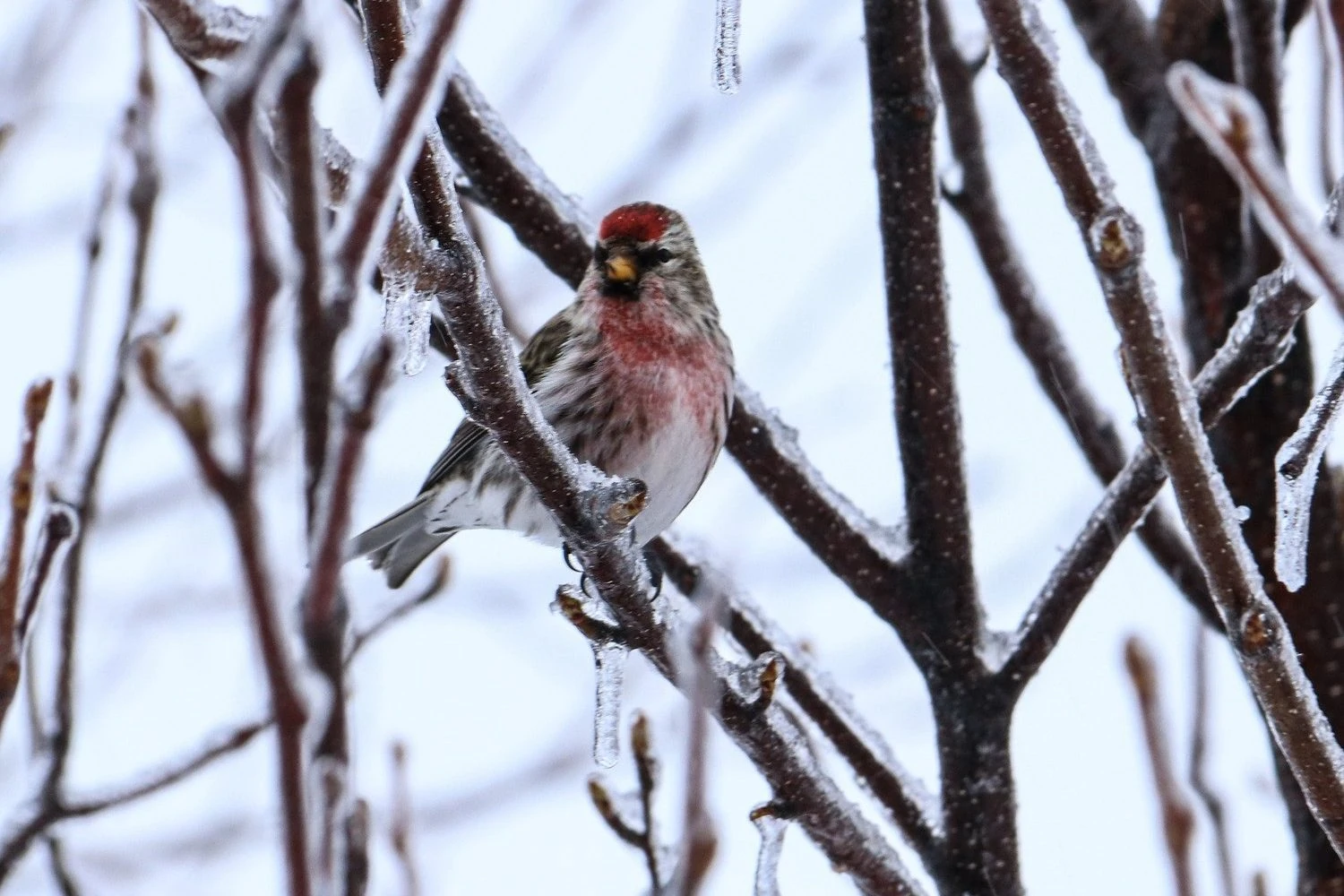
Common Redpolls are small and have red foreheads, and are brown and white streaked over the rest of their bodies. Males also have pink breasts, but females do not. They have small bills for finch and a short notched tail.
- Acanthis flammea
- Length: 4.7-5.5 in (12-14 cm)
- Weight: 0.4-0.7 oz (11-20 g)
- Wingspan: 7.5-8.7 in (19-22 cm)
Common Redpolls breed in artic in Canada and spend the winter in the rest of Canada and northern US states and less frequently in central US states.
In winter, they will sometimes tunnel into the snow to stay warm during the night. They can eat up to 42% of their body mass every day and can store up to 2 grams of seeds in a stretchy park of their esophagus.
You can find Common Redpolls in weedy fields or feeding on catkins in trees, but they will also come to feeders for small seeds such as nyjer seeds or thistle.
Common Redpoll Song:
Attract Common Redpolls to your backyard by feeding them nyjer seeds and shelled sunflower seeds.
Fun Fact: Common Redpolls can survive temperatures of -65 Fahrenheit without freezing to death. They add around 30% more feathers to stay warm.
23. Song Sparrow
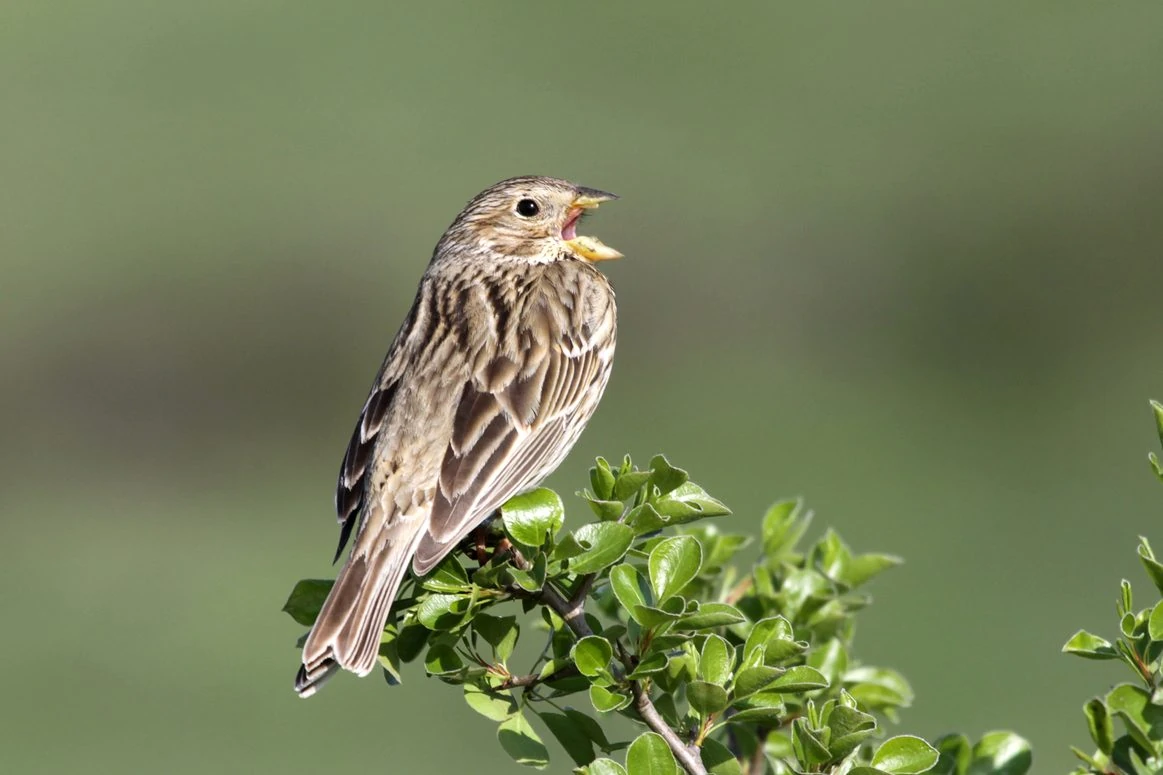
Song sparrows are not as remarkable looking as other backyard birds, but these predominantly brown-streaked birds use their almost constant song to attract mates in spring and summer.
- Melospiza melodia
- Length: 4.7-6.7 in (12-17 cm)
- Weight: 0.4-1.9 oz (12-53 g)
- Wingspan: 7.1-9.4 in (18-24 cm)
Song Sparrows live all year in the northern US states. Those that breed in Canada migrate to southern US states for winter.
They can be found in open, shrubby, and wet areas, often perched on a low shrub singing. They are often found at backyard feeders.
Song Sparrows eat a wide variety of insects and plants, including beetles, caterpillars, midges, spiders, and earthworms. They will also eat buckwheat, sunflower, raspberries, wild cherries, blackberries, wheat, and rice.
Song Sparrow Song:
Song Sparrow Call:
Attract Song Sparrows to your backyard feeders by putting black oil sunflower seeds, cracked corn, and nyjer on platform feeders.
24. Common Loon

While the Common Loon has a simple and plain name, its physical appearance and haunting call, particularly during the breeding season is anything but.
Common Loons are large, intricately-patterned black and white diving birds with red eyes during the breeding season. Their toes are webbed even though they are not a duck.
Non-breeding adults are mostly gray and white. Juveniles are grayish-brown and white with a scalloped pattern.
- Gavia immer
- Length: 28 – 36 in (71 – 91 cm)
- Weight: 145.6 oz (4126 g)
- Wingspan: 50 – 58 in (127 – 147 cm)
Common Loons breed in Canada and migrate to coastal areas of Canada and the US.
You can find Common Loons in large wooded lakes during the breeding season. In the winter, they migrate to coasts, estuaries, lakes, and streams that do not freeze.
Common Loons are stealthy and expert divers whose favorite food is fish. If there are not enough fish, they may eat snails, leeches, crustaceans, frogs, mollusks, and insect larvae.
Common Loon Calls:
Nests of Common Loons are often reused if successful and usually built on islands from grass moulded with their body.
The female will lay up to two eggs, and then both parents will incubate their eggs for about a month. Once they hatch, they will swim close to their parents and often have to rest on their parent’s back.
Fun Facts: Common Loons’ feet are positioned far back on their bodies which makes it difficult for them to walk on land but makes them efficient divers and swimmers underwater.
25. Bufflehead
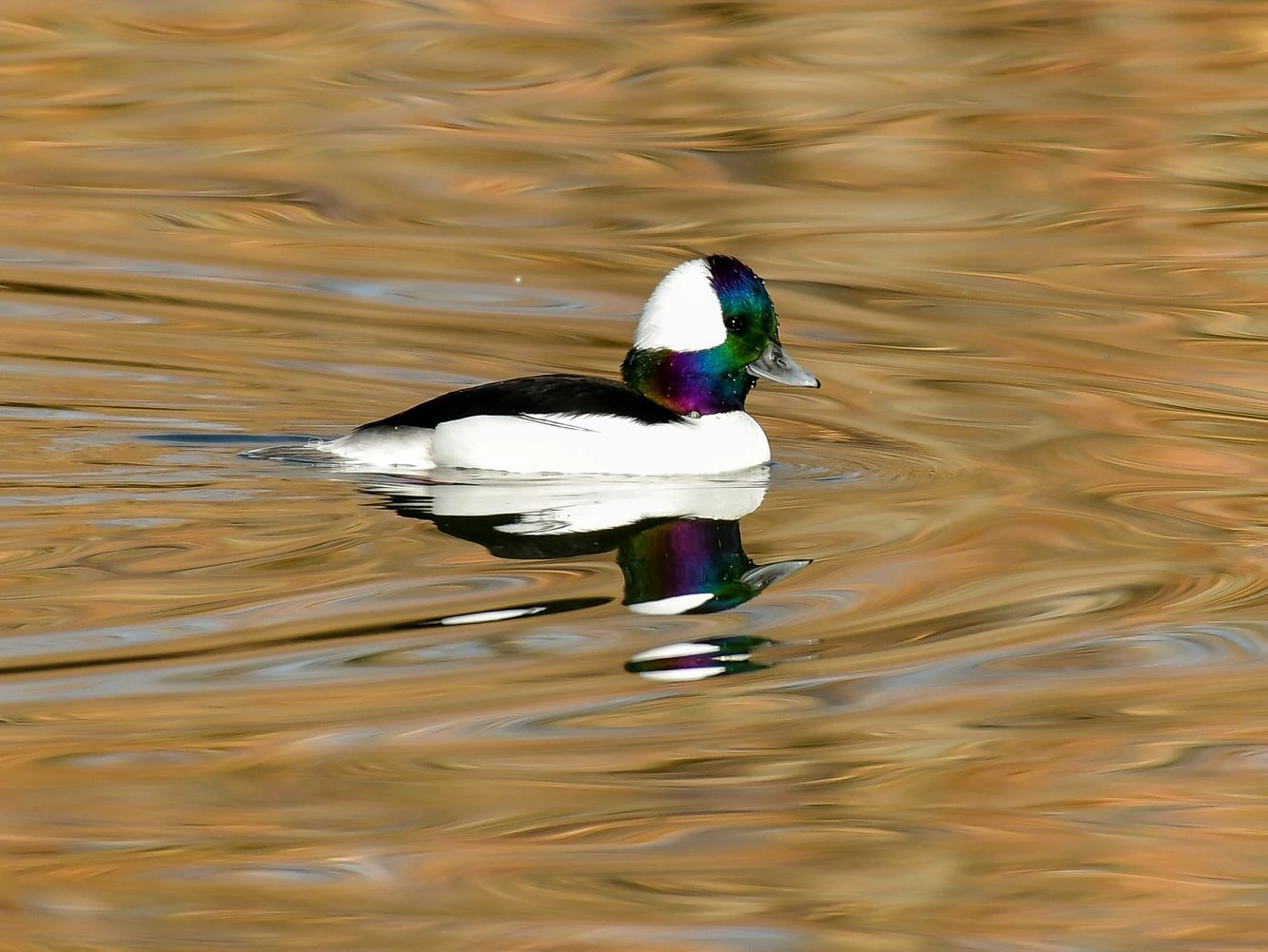
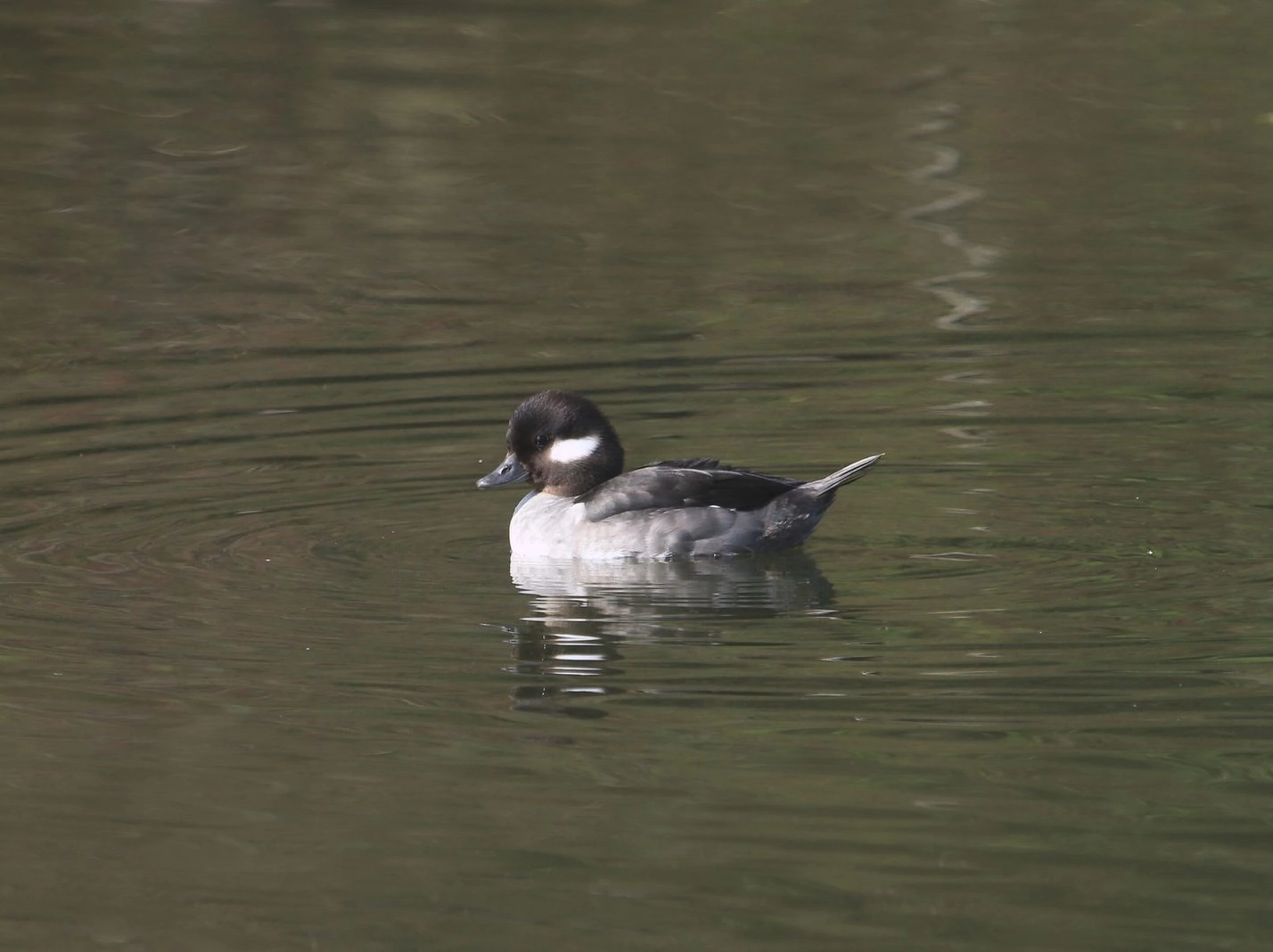
Buffleheads are small birds with bulbous heads, hence their name, “bullheaded,” from ancient Greek. Male Buffleheads are easily recognizable because of the huge white patch behind their eyes. This patch highlights the glossy green and purple colors on the crown, forehead, throat, and neck. The bottom half of their bodies are white, while the upper half is black.
Female Buffleheads look nothing like the males, except for the bulbous head. They have dark brown or black heads with a white patch below the eye. Their bottom half is gray, and their top half is black. Juveniles look similar to females with their brown heads and a white patch on the head.
- Bucephala albeola
- Length: 13 – 16 in (33 – 41 cm)
- Weight: 21.16 oz (600 g)
- Wingspan: 20 – 24 in (51-61 cm)
Buffleheads breed mainly in Canada before migrating to the US, northern Mexico, and Canada’s Pacific coast. They can be seen during migration in the Midwest and the Appellations.
You can find Buffleheads in small lakes and ponds with nearby poplar and aspen forests during the breeding season. In the winter, they move to protected coastal waters or shallow bays and inlets.
Buffleheads mostly dive as they forage for food. They catch mollusks, crustaceans, and aquatic insects, which they eat while underwater.
Bufflehead Calls: Buffleheads are quiet birds and don’t make particularly loud calls. Males usually only make sounds around the breeding season and make chattering sounds or squeals. Females call to their young.
Male Bufflehead call
Female Bufflehead call
Attract Buffleheads to your backyard by putting up nest boxes. There is a lot of nest competition with other goldeneyes, which drives Buffleheads to seek safer and better nesting areas.
Fun Fact: Buffleheads are monogamous ducks and may remain with their chosen mate for several years.
Winter vs Summer Birds New Brunswick
There are some birds that stay all year in New Brunswick but many migrate in or out in the spring and fall. These lists give you the most common birds recorded in checklists by bird watchers in summer or winter on ebird.
Winter Birds New Brunswick:
Black-capped Chickadee 57.93%
American Crow 54.24%
Blue Jay 33.24%
Mourning Dove 30.75%
Herring Gull 29.67%
American Goldfinch 28.70%
European Starling 23.59%
Great Black-backed Gull 20.55%
Red-breasted Nuthatch 20.16%
Downy Woodpecker 19.62%
Common Raven 18.79%
Hairy Woodpecker 18.76%
Rock Pigeon 18.47%
American Black Duck 16.16%
Dark-eyed Junco 16.07%
Summer Birds New Brunswick:
American Crow 52.10%
Song Sparrow 45.39%
American Robin 37.96%
American Goldfinch 36.16%
Herring Gull 35.49%
Black-capped Chickadee 33.62%
Double-crested Cormorant 28.84%
Great Black-backed Gull 26.67%
Cedar Waxwing 25.25%
Common Yellowthroat 24.90%
Mourning Dove 20.85%
American Redstart 20.84%
Red-eyed Vireo 20.73%
Common Grackle 20.38%
Yellow Warbler 19.37%

